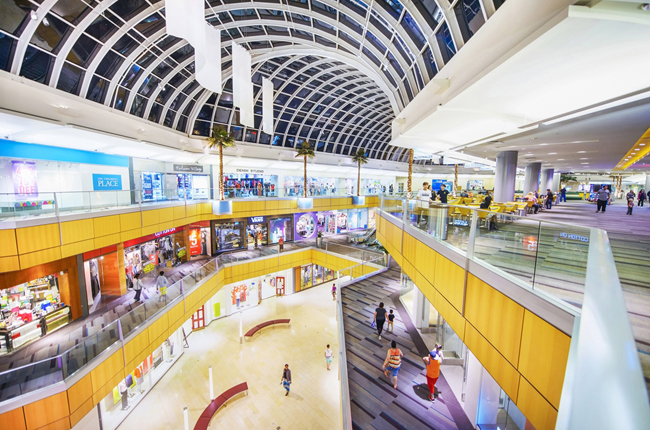
By Laura Agadoni
Imagine stepping outside your suburban hotel, and instead of jumping in a car to shop or eat, you can easily walk to all your favorite stores and restaurants.
Across the U.S., new hotels are enabling their guests to have local amenities on their doorstep – by backfilling vacant shopping center space. It’s not just an arrangement that benefits guests and the hotel chains; it’s also helping to revitalize American shopping centers that may have lost a middle-market anchor.
Over the past two years, large format anchors have closed. JCPenney, Macy’s, and Sears and Kmart are shutting down 324 stores between them across America this year, totaling upwards of 37-million square feet of space.
“Traditional department stores are facing headwinds as some consumers choose to shop in discount department stores, at specialty stores and on the web, all of which is contributing to the closure of middle-market anchor stores,” says Larry Jensen, Executive Vice President and Director of Development for JLL Retail.
New faces in old spaces
What will the new highest and best use for these department stores be? In some cases, they will be leased by other tenants of similar size, but shopping center owners and leasing agents are also evaluating what alternative uses could be woven into the vacant space.
“Recently vacated department stores can be leased out to new tenants, including hotels, restaurants, entertainment venues, grocers and even other department stores with better fiscal health prospects, but how the market and asset reacts to a store closing is based on location and other tenants within the center,” says Jensen.
The Crayola Experience, a family experience featuring hands-on activities for kids, in Minnesota’s Mall of America took the place of Bloomingdale’s. In Minneapolis’s Edina suburb, the Galleria shopping center just added a Westin.
Fitness chains have also taken over empty shopping center retail space, as have churches, healthcare providers, and grocery stores. “Rather than a vacancy, we always want a shopping center to have something that is activated and that will bring foot traffic to the asset,” says Jensen.
Converting vacant space to a modern hotel
The hotel-retail combination, where a hotel sits adjacent — or even attached — to a shopping center, is tried and tested in American cities. In recent times, hotel brands have been snapping up former retail space and converting it into luxury hotels. The Nines in Portland, Oregon, used to be a Meier & Frank department store, and plans are underway for Marriott-owned Moxy Hotels to repurpose the old Saks Fifth Avenue building in Pittsburgh, Pennsylvania.
Now, developers are taking vacant suburban, class B shopping center space and converting it from a store to a hotel. In fact, hotels are now one of the top options for either replacing anchor stores or sitting adjacent to a vacant anchor store, according to Jensen.
“A hotel makes sense,” says Lauro Ferroni, JLL’s Global Head of Hotels & Hospitality Research. “The astute asset manager who is overseeing a retail shopping center portfolio is going to think of this as a potential way to unlock additional value. A hotel user probably has some free time where they can shop and eat. In addition, a hotel brings something to the mix that is unique, and that serves as a competitive advantage.”
The best type of hotel for this purpose would often be a 150- to 175-room limited footprint full-service hotel, with some meeting space, a three-meal restaurant, and a lobby or lounge, explains Ferroni. The best shopping center candidates are ones that are doing well but that just lost an anchor tenant.
This type of conversion, because it’s unconventional, requires some creativity from an architectural standpoint. Because hotel brands tend to require a full window for all rooms, a vacant department store isn’t ideal.
“A typical shopping center anchor store is usually a one- or two-story building with a very deep and expansive floor plate. If you have a space that is super deep, you could only do hotel rooms around the outer perimeter,” explains Ferroni. “What might happen is that you would use the existing store for the lobby area, meeting space, or amenity space like a swimming pool or fitness center. On top of that, you would build a more narrow guest room tower, maybe three stories, where you put the bulk of the rooms.”
Spotting an opportunity
Using existing space can save hard construction costs. “A hotel owner can take advantage of something that has already been built,” says Ferroni. “You are spending to reconfigure, but you are opening a hotel at a lower cost than building something from scratch — and building something as nice as a purpose-built building.” Another advantage is that, since the retail center just lost a tenant, ample parking probably already exists, which presents another money-saving advantage for hotel owners.
“Shopping center owners need to be stewards for the investment,” says Ferroni. A hotel might not always be the right fit – the building could be the wrong size, the layout might be too constrictive or it could be located at an end of the shopping center with less access for pedestrians or cars.
But it could well be worth taking a look, says Ferroni. “Fortune favors those who are creative,” he says. “Hotels can definitely add something to a shopping center. And hotels that can offer interesting shopping and dining selections have an advantage over freestanding hotels that offer only lodging.”


